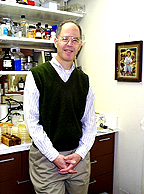
| T H E N I H C A T A L Y S T | N O V E M B E R – D E C E M B E R 2000 |
|
|
|
REED WICKNER: PRION PROFILER |
|
 |
|
Reed
Wickner
|
NIDDK’s Reed Wickner, one of NIH’s two newly elected members of the prestigious National Academy of Sciences, does things a little differently from the rest of the crowd. Wickner’s groundbreaking work established that certain elements in yeast are prions—an abnormal form of a protein capable of "infecting" normal molecules of the protein and converting them to the abnormal prion form. Mammalian prions are believed to cause "mad cow" disease and Creutzfeldt-Jakob disease (CJD).
Wickner’s route to basic science showed his preference for the road less traveled. As an undergraduate at Cornell, he was drawn to mathematics and earned his bachelor’s in that field. But instead of pursuing math further, Wickner decided to follow in his father’s footsteps to become a physician. While in medical school, he was more intrigued by the science behind the disease than by the art of diagnosis. This led to yet another career move—becoming a postdoctoral scientist here at NIH. He studied enzyme biochemistry with Herb Tabor, who, Wickner says, "taught me how to do science." Next came training with Jerard Hurwitz at New York’s Albert Einstein College of Medicine, where Wickner worked on the purification and characterization of DNA polymerase II.
But it was at NIH where Wickner established his own lab as a principal investigator in yeast genetics. Many factors drew him back. Freedom from writing grants and teaching affords him the luxury of doing experiments himself. "I’ve been very lucky over the years to have some really excellent postdocs, but I also enjoy doing research myself. And my impression from my friends in universities is they don’t really have time."
|
VERY
RECENT WORK FROM THE WICKNER LAB HAS FOUND THAT
A PROTEIN CALLED MKS1IS
REQUIRED FOR THE TRANSFORMATION OF THE NORMAL URE2
PROTEIN TO THE ABNORMAL PRION FORM [URE3]. THIS
IS THE FIRST REPORT OF SUCH A HELPER PROTEIN FOR PRION FORMATION.
|
Pursuing the unusual has paid off for Wickner. His lab studies non-Mendelian genetic elements in budding yeast, which include RNA viruses, a plasmid called 2ÁDNA, [PSI+], and [URE3]. One of Wickner’s key insights came as he was writing a review article on the elements in 1989—a time when he says "the interest in nonchromosomal genetic elements in the yeast world . . . had mostly died out." Wickner realized that two elements, [URE3] and [PSI+], might really be yeast prions. So, he started working on [URE3], building on "beautiful work" by Aigle and Lacroute who discovered it, with elegant experiments of his own. In 1994, Wickner proposed three oft-cited genetic criteria for calling something a prion: 1) "Curing" a prion can be reversed—the prion state can spontaneously reappear after the phenotype has vanished; 2) An excess of the normal protein can increase the chance of prion appearance; and 3) The phenotype of an organism with a prion is the same as the phenotype of a mutant in the gene for the protein. As Wickner has shown, [URE3] meets the three genetic criteria for being a prion. [URE3] protein also forms the characteristic aggregates for which prions are famous.
Very recent work from the Wickner lab has found that a protein called Mks1 is required for the transformation of the normal Ure2 protein to the abnormal prion form [URE3](see box to right). This is the first report of such a helper protein for prion formation. Identification of an analogous factor in animals could help researchers treat, or perhaps even prevent, prion-induced disease.
Refreshingly enthusiastic about his research, Wickner says the same force that fueled the love of his undergrad major now drives his work. "Mathematics is what I really like—mathematics and physics. Genetics is very logical—it’s kind of like the mathematics of biology." At the same time, he says that he has made good use of his medical training. He observed that what he is really studying is an infection of yeast. "I view [the prions] as parasites . . . so that while other people are looking for how this is an advantage to yeast, I’m not always thinking of it in those terms."
Wickner says he would
advise early career scientists to do as he did and march to a different drummer.
"I’m not sure this advice would be what other people would give, but
my advice is . . . don’t propose as your work when you become independent
a linear continuation of what you’ve been doing as a postdoc. Propose to
do something that is obviously your own." This could mean applying the
biochemical or genetic techniques you have learned to a new system, or staying
with the same organism, but addressing a new problem. "It’s not easy
to do," he concedes, but postdocs should try to think beyond their immediate
experiments toward the bigger picture. "You need to see something and see
its interest and importance that other people don’t see."
![]()
NIDDK postdoc Herman Edskes has received the second annual Norman P. Salzman Memorial Award in Virology, an award presented by the Foundation for the NIH for contributions in basic virology while working at NIH or SAIC. Edskes received the award for his paper entitled "A protein required for prion generation: [URE3] induction requires the Ras-regulated Mks1 protein"—with special recognition to the winner’s mentor, Reed Wickner. |